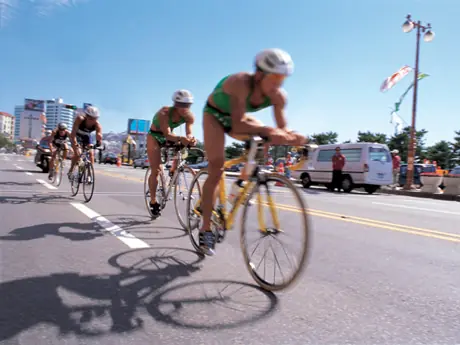
How do they go so fast? We've all marveled at the run and bike splits of the fastest duathletes and wondered how they can sustain their pace on the run and manage their impressive bike speeds.
At the 2010 USA Triathlon National Duathlon Championships in Richmond, Virginia, the age-group champion and overall fastest time was 1:30:39 for a course that consisted of a 5K run, 38K bike and 5K run. Kaleb VanOrt, a 26-year-old from Mishawaka, Indiana, maintained a 4:55 pace on the first run, a 24.05 mph pace on the bike and finished with a 4:59 pace on the second run. His margin of victory was 26 seconds over the course of the race.
More: 3 Steps to a Faster Run Split
VanOrt's speed on the run is not accidental. Like many top runners, he comes from a cross country background. He went on to run cross country and indoor and outdoor track at Notre Dame. Since VanOrt's primary background is running, it gives him the strength and depth of fitness to run well off the bike. The lesson is that a deep fitness base and a lot of speed work over time result in a durable level of speed, and fitness that can stand up to a crowded race schedule and still provide race winning speed off the bike.
Perhaps the most impressive thing about VanOrt's performance is that he owned the fastest second run by 42 seconds, nearly twice his margin of victory. Equally interesting is that his bike split did not crack the top-five bike splits—he won on the strength of his runs.
To win at duathlon (or any multisport event) you have to be able to run fast off the bike on tired legs. VanOrt is a great example of this as his deep fitness base and extensive track background built durable speed into his legs.
More: 3 Workouts to Improve Your Run
Another key to duathlon speed is a precise understanding of the course for race day. The bike course in Tucson has thirteen turns in two laps of at least 90 degrees, with two 180-degree turns in the 35K stretch. At an average speed of about 25 mph for the top athletes, that means rounding a corner at a relatively high speed every 6.5 to 7 minutes during a 53-minute bike split. Additionally, there are 20 wide, sweeping curves on the course in Tucson. Doing intervals out of corners and learning to maintain speed through turns will be an important tactical skill in Tucson.
The brick training session is a key building block to duathlon speed for age-groupers of any speed and skill level. Run/bike/run repeats not only train quality running on tired legs after a hard bike interval; they also are an opportunity to practice transitions at race pace. A brick training session with repeated transitions is one of the most intense but technically important training sessions you or your coach can build into your schedule.
More: Brick Workouts to Help You Finish Fast
Another key to the incredible splits we see from the top duathletes in each age category is a deep aerobic fitness base. The offseason base miles, especially on the run, done at an easy-to-moderate pace help promote aerobic efficiency and build strength in the skeleton and connective tissues when combined with nutrition and recovery. Speed work doesn't work without the base miles. As a contributor on the Slowtwitch.com user forum once said, "Speed work is the icing on the cake." The base miles are the cake. With no base miles, you have no cake to put icing on.
A final key to duathlon speed is learning to run well on tired legs. The gritty reality of going fast is you simply have to train hard even when you are tired. There is a difference between being over-trained and training when tired and physiological markers such as resting heart rate can provide that perspective. The faster athletes are the ones with the deep fitness base and a lot of speed work in their training log. Like all endurance sports, there are no short cuts to high speed.
More: Learn to Run on Tired Legs
 Figure out your ideal pace with a pace calculator and find a duathlon to try.
Figure out your ideal pace with a pace calculator and find a duathlon to try.About the Author




Discuss This Article